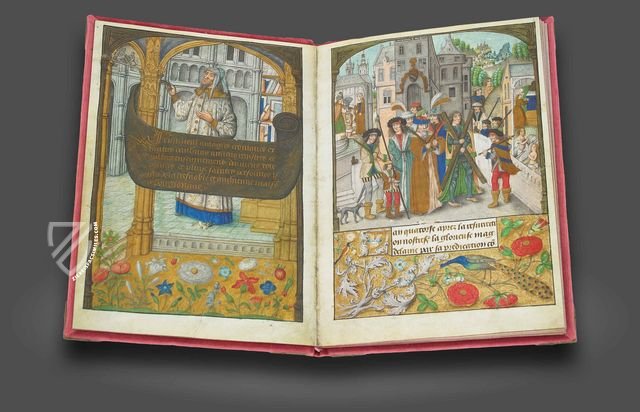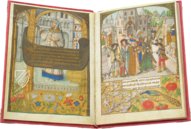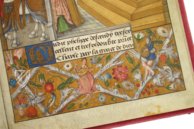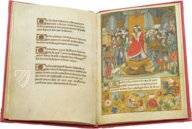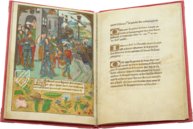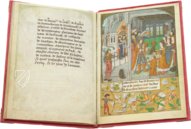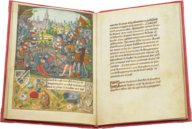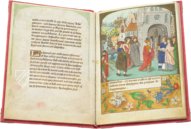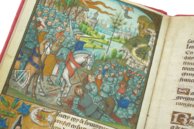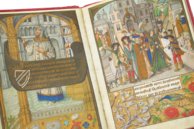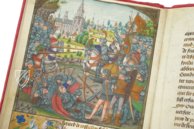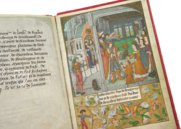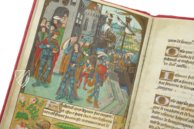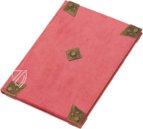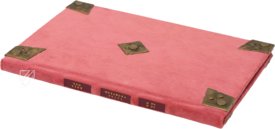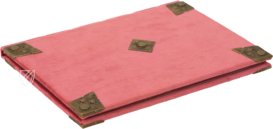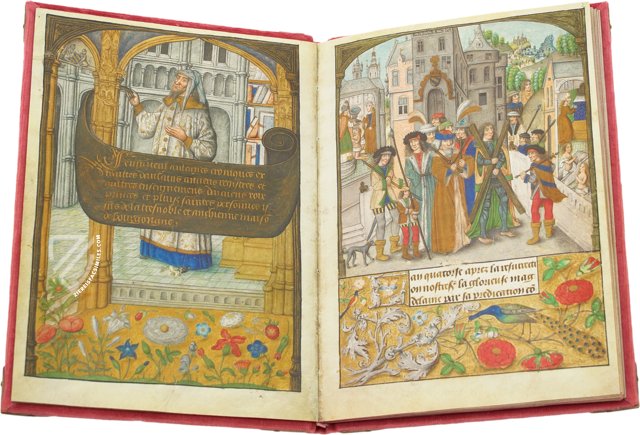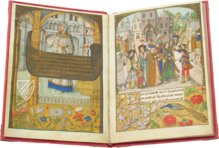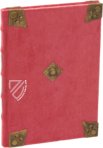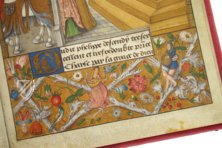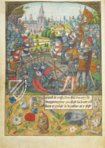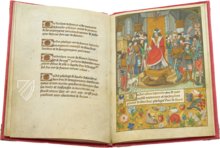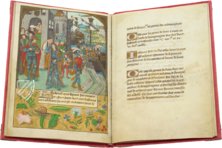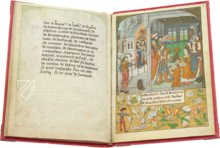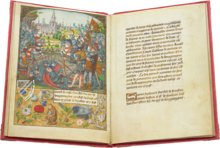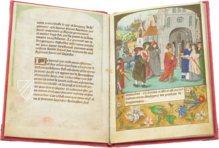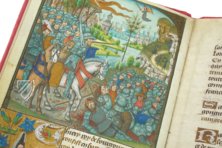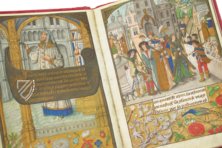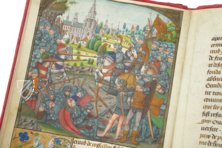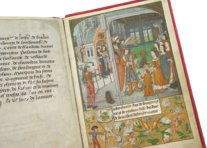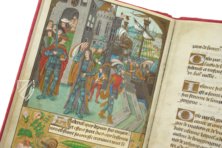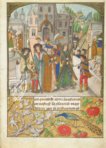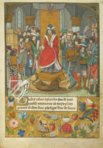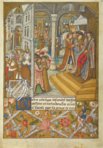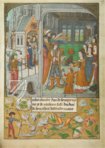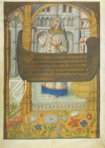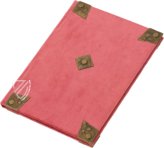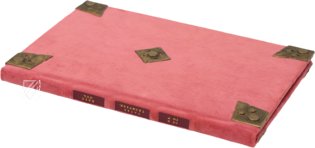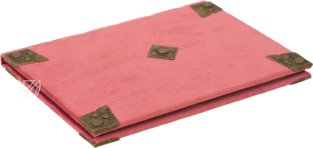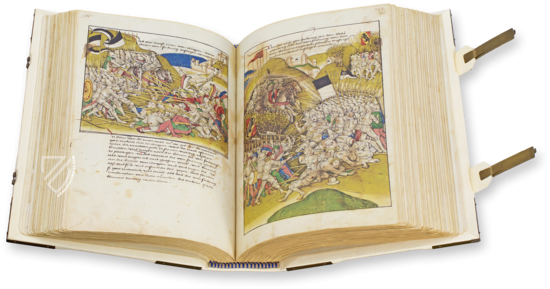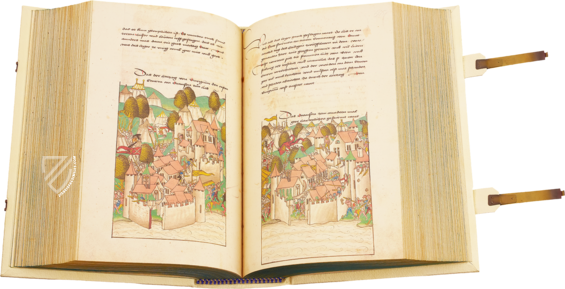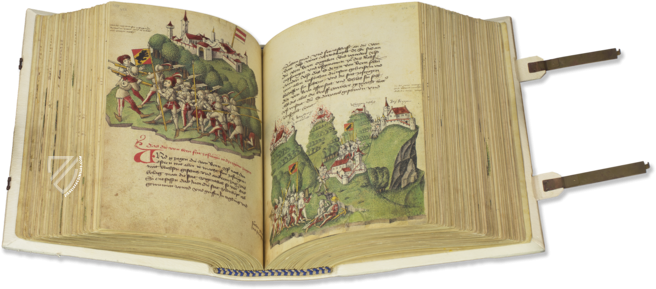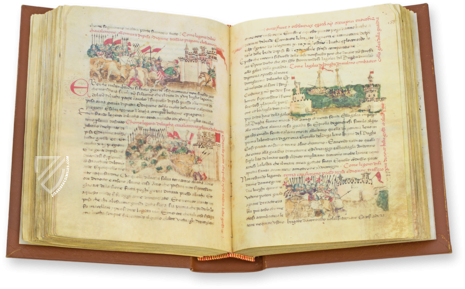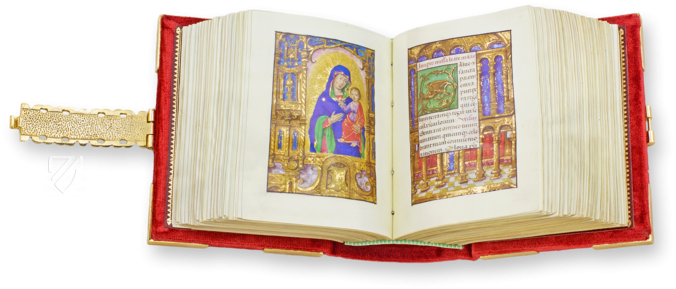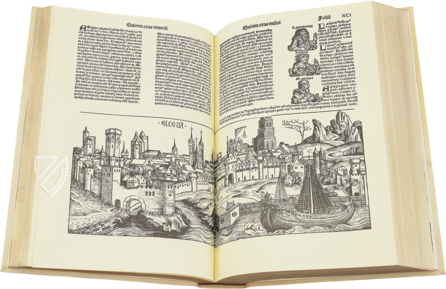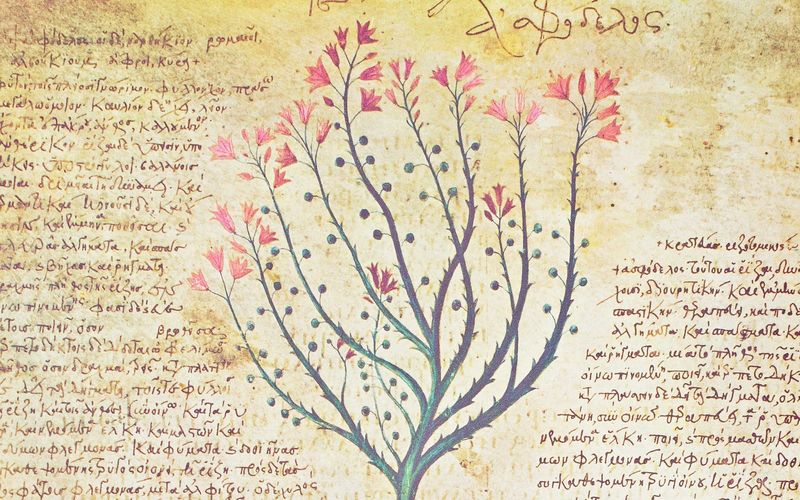Flemish Chronicle of Philip the Fair
(1,000€ - 3,000€)
This dazzling Flemish Chronicle on the history of the Burgundian duchy probably originated between 1485 and 1490 and was intended to be a schoolbook for Philip the Fair (1478-1506). The later Duke of Burgundy and first Habsburg to become king in Spain was to be educated about the historical events of the 14th and 15th centuries by means of the text and at the same time understand the importance of his family through the splendid depictions of his ancestors. Eleven splendid full-page miniatures with explanatory captions show, for example, the legendary Burgundian King Stephen of Burgundy, Charlemagne and Mary Magdalene in noble courtly scenes, in the dramatic turmoil of war or in front of authentic cityscapes. The so-called Master of the Trivial Heads was responsible for the artistic and meaningful illumination. He was probably hired by Philip's teacher, Olivier de la Marche, who in turn had himself immortalized in a portrait within the manuscript.
Flemish Chronicle of Philip the Fair
One of the few illuminated children’s books originated in Belgian Bruges ca. 1485–90. The splendidly colorful pictorial history of the Duchy of Burgundy with short text passages originated as a schoolbook for the then seven-year-old Philip the Fair (1478–1506). He was supposed to be the first Hapsburg king in Spain and would rule over the Kingdoms of Castile and León. The vivid and bright pictures of the 30-page manuscript visualized the significance of his family for him at an early age. A portrait of the author of the text, who also probably Philip’s teacher, the chronicler and poet Olivier de la Marche, serves as the prelude for the eleven full-page miniatures and numerous initials both large and small.
Ducal Miniatures
The content of the manuscript is concerned with a time period stretching from the 1st to the 15th century. In doing so, one not only finds ostentatious portraits of legendary rulers like Stephen of Burgundy (1065–1102), but historical figures like Charlemagne, or Mary Magdalene who supposedly baptized the first King of the Burgundians. These images are accompanied by numerous vivid scenes playing out before a backdrop of imposing urban architecture and extensive riverscapes.
A Masterpiece of the Ghent-Bruges School
The wealthy trading cities of Flanders attracted many artists and miniaturists, and highly talented masters were working in Bruges and Ghent by the second half of the 15th century. The Master of the Trivial Heads was engaged as an assistant to the Master of Edward IV in a bustling workshop in Bruges, and was within the circle of this so-called Ghent-Bruges school, which dominated the art scene. He is the responsible party for the marvelously fantastic miniatures of the Flemish Chronicle of Philip the Fair.
An Ornate Chronicle for Hard Times
Such luminous depictions hardly give one the impression that the dukes of Burgundy were already in a period of decline during the time of their making, and longed to return to the years of splendor they had depicted in manifold ways. Only a century after their ducal dynasty was created, it suddenly came to an end with the death of Charles the Bold in the year 1477.
Codicology
- Alternative Titles
- Flämische Bilderchronik Philipps des Schönen
La Chronique flamande de Philippe le Beau
Chroniques abrégées des Anciens Rois et Ducs de Bourgogne - Size / Format
- 30 pages / 23.0 × 17.0 cm
- Origin
- Belgium
- Date
- Ca. 1485–1490
- Epochs
- Style
- Language
- Script
- Gothic cursive
- Illustrations
- 11 full-page miniatures and numerous initials both large and small
- Content
- Pictorial History of the Duchy of Burgundy with rather little text because it was intended for the instruction of Philip the Fair as a child
- Patron
- Probably Olivier de la Marche, tutor of Philip the Fair
- Artist / School
- Master of Edward IV
- Previous Owners
- Philip the Fair
Ambroise Firmin Didot
Henry Yates Thompson
Flemish Chronicle of Philip the Fair
A Noble Family Portrait
Wearing a feathered cap, long ermine-lined cloak, and knee-high boots, Maximilian I gives a knight’s sword to his young son, Philip, who is standing next to his mother, Mary of Burgundy, daughter and heir of Charles the Bold. Both Maximilian and Mary have their own beautifully dressed entourages. A small lion sitting in front of a green couch watches from the background where there are windows looking out onto a pleasant cityscape and a corridor leading to an unseen part of the interior.
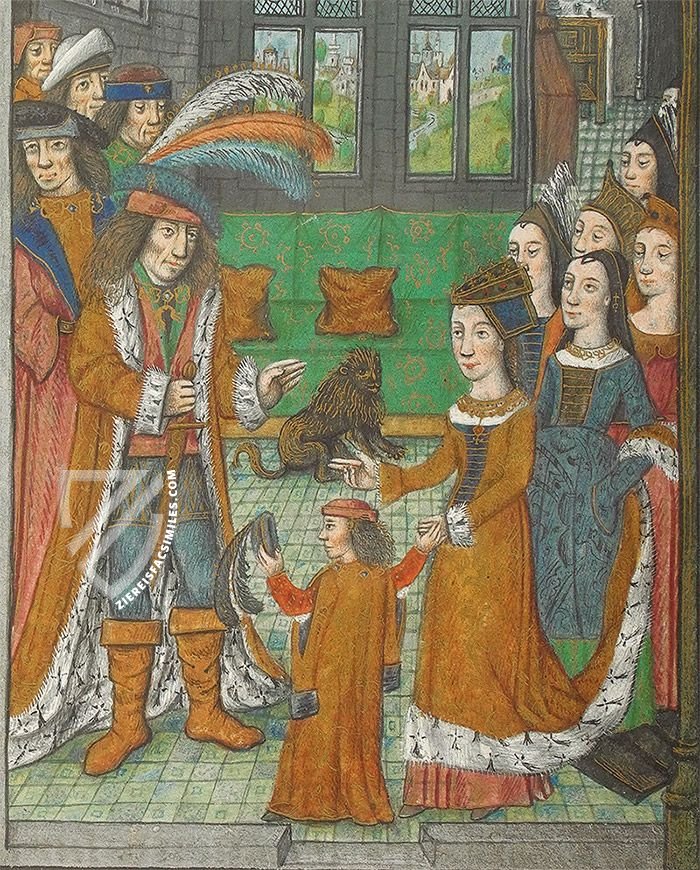
Flemish Chronicle of Philip the Fair
Charles the Bold and his Court
Charles the Bold dreamed of transforming the duchy of Burgundy into a kingdom and pursued an aggressive foreign policy to unite his lands into a continuous territorial unit. He thus triggered the Burgundian Wars, which resulted in his death at the Battle of Nancy and the subsequent division of his realm between France and the Hapsburg Empire.
The court of the dukes of Burgundy was arguably the grandest and most sophisticated in late medieval Europe with a manuscript culture that was second to none. This miniature page shows the richly dressed Burgundian nobility with Charles enthroned and holding a scepter. Two musicians are shown at the bottom of the page playing for the court while magnificent warhorses are shown in the street outside.
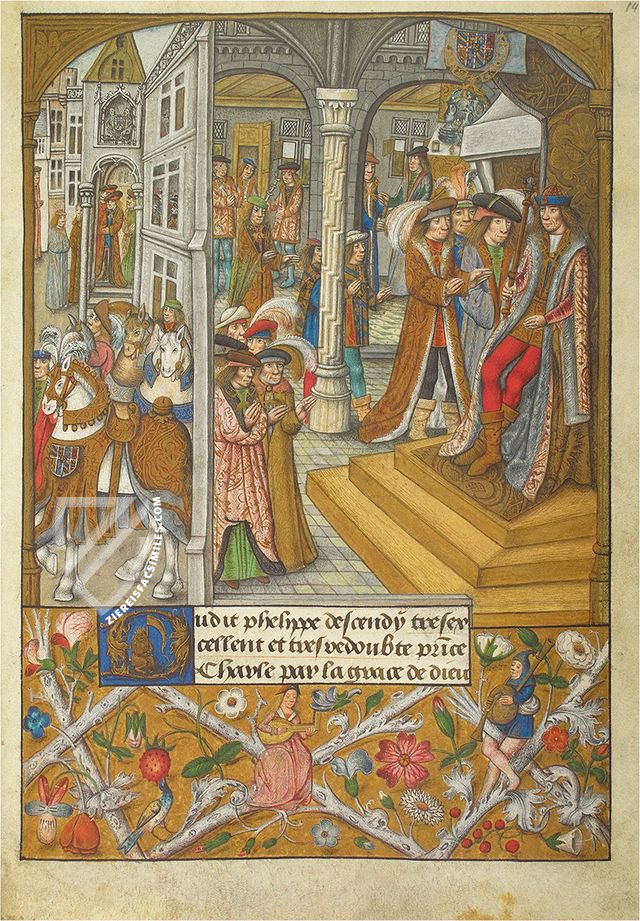
#1 Das Flämische Bilderchronik Philipps des Schönen
Languages: German, French, English
(1,000€ - 3,000€)
- Treatises / Secular Books
- Apocalypses / Beatus
- Astronomy / Astrology
- Bestiaries
- Bibles / Gospels
- Chronicles / History / Law
- Geography / Maps
- Saints' Lives
- Islam / Oriental
- Judaism / Hebrew
- Single Leaf Collections
- Leonardo da Vinci
- Literature / Poetry
- Liturgical Manuscripts
- Medicine / Botany / Alchemy
- Music
- Mythology / Prophecies
- Psalters
- Other Religious Books
- Games / Hunting
- Private Devotion Books
- Other Genres
- Afghanistan
- Armenia
- Austria
- Belgium
- Belize
- Bosnia and Herzegovina
- China
- Colombia
- Costa Rica
- Croatia
- Cyprus
- Czech Republic
- Denmark
- Egypt
- El Salvador
- Ethiopia
- France
- Germany
- Greece
- Guatemala
- Honduras
- Hungary
- India
- Iran
- Iraq
- Israel
- Italy
- Japan
- Jordan
- Kazakhstan
- Kyrgyzstan
- Lebanon
- Liechtenstein
- Luxembourg
- Mexico
- Morocco
- Netherlands
- Palestine
- Panama
- Peru
- Poland
- Portugal
- Romania
- Russia
- Serbia
- Spain
- Sri Lanka
- Sweden
- Switzerland
- Syria
- Tajikistan
- Turkey
- Turkmenistan
- Ukraine
- United Kingdom
- United States
- Uzbekistan
- Vatican City
- A. Oosthoek, van Holkema & Warendorf
- Aboca Museum
- Ajuntament de Valencia
- Akademie Verlag
- Akademische Druck- u. Verlagsanstalt (ADEVA)
- Aldo Ausilio Editore - Bottega d’Erasmo
- Alecto Historical Editions
- Alkuin Verlag
- Almqvist & Wiksell
- Amilcare Pizzi
- Andreas & Andreas Verlagsbuchhandlung
- Archa 90
- Archiv Verlag
- Archivi Edizioni
- Arnold Verlag
- ARS
- Ars Magna
- ArtCodex
- AyN Ediciones
- Azimuth Editions
- Badenia Verlag
- Bärenreiter-Verlag
- Belser Verlag
- Belser Verlag / WK Wertkontor
- Benziger Verlag
- Bernardinum Wydawnictwo
- BiblioGemma
- Biblioteca Apostolica Vaticana (Vaticanstadt, Vaticanstadt)
- Bibliotheca Palatina Faksimile Verlag
- Bibliotheca Rara
- Boydell & Brewer
- Bramante Edizioni
- Bredius Genootschap
- Brepols Publishers
- British Library
- C. Weckesser
- Caixa Catalunya
- Canesi
- CAPSA, Ars Scriptoria
- Caratzas Brothers, Publishers
- Carus Verlag
- Casamassima Libri
- Centrum Cartographie Verlag GmbH
- Chavane Verlag
- Christian Brandstätter Verlag
- Circulo Cientifico
- Club Bibliófilo Versol
- Club du Livre
- CM Editores
- Collegium Graphicum
- Collezione Apocrifa Da Vinci
- Comissão Nacional para as Comemorações dos Descobrimentos Portugueses
- Coron Verlag
- Corvina
- CTHS
- D. S. Brewer
- Damon
- De Agostini/UTET
- De Nederlandsche Boekhandel
- De Schutter
- Deuschle & Stemmle
- Deutscher Verlag für Kunstwissenschaft
- DIAMM
- Droz
- E. Schreiber Graphische Kunstanstalten
- Ediciones Boreal
- Ediciones Grial
- Ediclube
- Edições Inapa
- Edilan
- Editalia
- Edition Deuschle
- Edition Georg Popp
- Edition Leipzig
- Edition Libri Illustri
- Editiones Reales Sitios S. L.
- Éditions de l'Oiseau Lyre
- Editions Medicina Rara
- Editorial Casariego
- Editorial Mintzoa
- Editrice Antenore
- Editrice Velar
- Edizioni Edison
- Egeria, S.L.
- Eikon Editores
- Electa
- Emery Walker Limited
- Enciclopèdia Catalana
- Eos-Verlag
- Ephesus Publishing
- Ernst Battenberg
- Eugrammia Press
- Extraordinary Editions
- Fackelverlag
- Facsimila Art & Edition
- Facsimile Editions Ltd.
- Facsimilia Art & Edition Ebert KG
- Faksimile Verlag
- Feuermann Verlag
- Folger Shakespeare Library
- Franco Cosimo Panini Editore
- Friedrich Wittig Verlag
- Fundación Hullera Vasco-Leonesa
- G. Braziller
- Gabriele Mazzotta Editore
- Gebr. Mann Verlag
- Gesellschaft für graphische Industrie
- Getty Research Institute
- Giovanni Domenico de Rossi
- Giunti Editore
- Graffiti
- Grafica European Center of Fine Arts
- Guido Pressler
- Guillermo Blazquez
- Gustav Kiepenheuer
- H. N. Abrams
- Harrassowitz
- Harvard University Press
- Helikon
- Hendrickson Publishers
- Henning Oppermann
- Herder Verlag
- Hes & De Graaf Publishers
- Hoepli
- Holbein-Verlag
- Houghton Library
- Hugo Schmidt Verlag
- Idion Verlag
- Il Bulino, edizioni d'arte
- ILte
- Imago
- Insel Verlag
- Insel-Verlag Anton Kippenberger
- Instituto de Estudios Altoaragoneses
- Instituto Nacional de Antropología e Historia
- Istituto dell'Enciclopedia Italiana - Treccani
- Istituto Ellenico di Studi Bizantini e Postbizantini
- Istituto Geografico De Agostini
- Istituto Poligrafico e Zecca dello Stato
- Italarte Art Establishments
- Jan Thorbecke Verlag
- Johnson Reprint Corporation
- Josef Stocker
- Josef Stocker-Schmid
- Jugoslavija
- Karl W. Hiersemann
- Kasper Straube
- Kaydeda Ediciones
- Kindler Verlag / Coron Verlag
- Kodansha International Ltd.
- Konrad Kölbl Verlag
- Kurt Wolff Verlag
- La Liberia dello Stato
- La Linea Editrice
- La Meta Editore
- Lambert Schneider
- Landeskreditbank Baden-Württemberg
- Leo S. Olschki
- Les Incunables
- Liber Artis
- Library of Congress
- Libreria Musicale Italiana
- Lichtdruck
- Lito Immagine Editore
- Lumen Artis
- Lund Humphries
- M. Moleiro Editor
- Maison des Sciences de l'homme et de la société de Poitiers
- Manuscriptum
- Martinus Nijhoff
- Maruzen-Yushodo Co. Ltd.
- MASA
- Massada Publishers
- McGraw-Hill
- Metropolitan Museum of Art
- Militos
- Millennium Liber
- Müller & Schindler
- Nahar - Stavit
- Nahar and Steimatzky
- National Library of Wales
- Neri Pozza
- Nova Charta
- Oceanum Verlag
- Odeon
- Orbis Mediaevalis
- Orbis Pictus
- Österreichische Staatsdruckerei
- Oxford University Press
- Pageant Books
- Parzellers Buchverlag
- Patrimonio Ediciones
- Pattloch Verlag
- PIAF
- Pieper Verlag
- Plon-Nourrit et cie
- Poligrafiche Bolis
- Presses Universitaires de Strasbourg
- Prestel Verlag
- Princeton University Press
- Prisma Verlag
- Priuli & Verlucca, editori
- Pro Sport Verlag
- Propyläen Verlag
- Pytheas Books
- Quaternio Verlag Luzern
- Reales Sitios
- Recht-Verlag
- Reichert Verlag
- Reichsdruckerei
- Reprint Verlag
- Riehn & Reusch
- Roberto Vattori Editore
- Rosenkilde and Bagger
- Roxburghe Club
- Salerno Editrice
- Saltellus Press
- Sandoz
- Sarajevo Svjetlost
- Schöck ArtPrint Kft.
- Schulsinger Brothers
- Scolar Press
- Scrinium
- Scripta Maneant
- Scriptorium
- Shazar
- Siloé, arte y bibliofilia
- SISMEL - Edizioni del Galluzzo
- Sociedad Mexicana de Antropología
- Société des Bibliophiles & Iconophiles de Belgique
- Soncin Publishing
- Sorli Ediciones
- Stainer and Bell
- Studer
- Styria Verlag
- Sumptibus Pragopress
- Szegedi Tudomànyegyetem
- Taberna Libraria
- Tarshish Books
- Taschen
- Tempus Libri
- Testimonio Compañía Editorial
- Thames and Hudson
- The Clear Vue Publishing Partnership Limited
- The Facsimile Codex
- The Folio Society
- The Marquess of Normanby
- The Richard III and Yorkist History Trust
- Tip.Le.Co
- TouchArt
- TREC Publishing House
- TRI Publishing Co.
- Trident Editore
- Tuliba Collection
- Typis Regiae Officinae Polygraphicae
- Union Verlag Berlin
- Universidad de Granada
- University of California Press
- University of Chicago Press
- Urs Graf
- Vallecchi
- Van Wijnen
- VCH, Acta Humaniora
- VDI Verlag
- VEB Deutscher Verlag für Musik
- Verlag Anton Pustet / Andreas Verlag
- Verlag Bibliophile Drucke Josef Stocker
- Verlag der Münchner Drucke
- Verlag für Regionalgeschichte
- Verlag Styria
- Vicent Garcia Editores
- W. Turnowski Ltd.
- W. Turnowsky
- Waanders Printers
- Wiener Mechitharisten-Congregation (Wien, Österreich)
- Wissenschaftliche Buchgesellschaft
- Wissenschaftliche Verlagsgesellschaft
- Wydawnictwo Dolnoslaskie
- Xuntanza Editorial
- Zakład Narodowy
- Zollikofer AG

